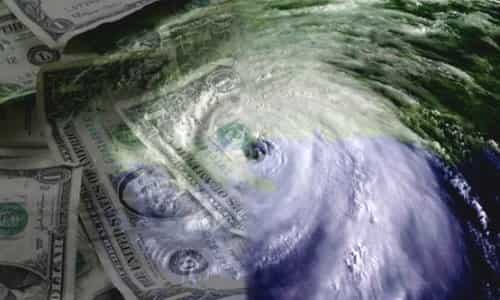The Approaching Economic Storm
 By PNW Staff October 24, 2016
Share this article:
By PNW Staff October 24, 2016
Share this article:
The next recession appears likely to hit in the spring of 2017, and
many experts are expressing increased concern over the weakened
position of the Federal Reserve.
After years
of low rates from the Federal Reserve and massive stimulus programs from
China, there may be very little left that governments can do to push
back against this macroeconomic tide. What is worse, it is widely
believed that the Fed is planning to raise rates in December of 2016.
Whereas
its intention may be to provide room to lower rates later in a crisis,
there is also a strong chance that this could help precipitate the
recession.
Though notoriously difficult to
predict, financial cycles are an inescapable part of a fiat currency
system based on fractional reserve banking.
A currency model built on debt and controlled with the
imperfect levers of interest rates set by central banks, the sin of
usury, writ large across the globe, will expand and contract. The only
warnings of the coming crash are a set of leading economic indicators,
perhaps six months to a year in advance.
With
many calling the recovery from the 2008 recession both weak and
artificial, the stage is set for a devastating economic pullback. But
why are financial experts predicting the chances of a recession in the
next year with estimates ranging from as low as 25% to a 60% or higher?
Home Price Inflation
With
the memory of the last housing bubble still fresh, home prices in the
US have risen sharply since 2012 and are now nearing the pre-crash highs
of 2006.
This rise in asset prices has
outstripped the slowing rate of income growth. Low interest rates have
fueled a paper-recovery that could very soon prove to be unsustainable
at these levels.
Decline in Corporate Profits
We
are now in the fifth quarter of declining corporate profits, a key
leading indicator of overall economic health. Stock prices can be
manipulated, asset values can inflate and unemployment numbers are
notoriously unreliable, but corporate profits drive economic expansion,
hiring and tax revenues.
The effects are not
immediate on a macro level but instead lead the cycle by between six and
nine months. But dwindling liquidity levels are now being felt
globally. Michael Howell of CrossBorder Capital Group stated this month
that "We are seeing a serious deterioration on a monthly basis." He went
on to say, "We think the US is heading for recession by the Spring of
2017.
It is absolutely bonkers for the Fed to
even think about raising rates right now." The cut-backs corporations
are now imposing will soon be felt globally.
The Fed Using Repos to Pump Liquidity into Markets
The
Federal Reserve has been using a macroeconomic lever known as
"reverse-repos" to inject additional liquidity into the market. With
little room to drop the Fed Funds Rate any further, the American Central
Bank has turned to other methods to stimulate the economy in the face
of shrinking corporate profits.
According to
the analysts of CrossBorder, the liquidity levels in the US are now
nearing the same inflection points seen a shortly before the recessions
of 1990, 2001 and in November 2007, just over a year before the Lehman
Brothers implosion.
Fed Funds Rate Hike Expected in December 2016
Even
the vice-chairmen of the Federal Reserve, Stanley Fischer, admitted
this week that the Fed has little left in its toolbox after keeping
interest rates so low for so long and that this, "could therefore lead
to longer and deeper recessions when the economy is hit by negative
shocks."
His solution? Raise the interest
rates now while the economy is still in motion to create what he has
called "a buffer", or room to lower rates again in the coming
recession.
This move however, is considered by
many market experts to be extremely dangerous because it threatens to
act as the catalyst for the recession it hopes to cure.
The Treasury Yield Curve
The
analysts at Deutsche Bank, led by Dominic Konstam, point to a narrowing
in the rates between the three-month and ten-year US treasury bonds.
This yield curve is an important predictor of the future economic
conditions and if the natural rate differences are taken into account,
this curve has already inverted.
Deutsche Bank's analysis now believe that this indicates a
60% chance of a recession occurring in the US within the next nine
months.
Sovereign Debt Ratios
The
ratio of national debt to countries' gross domestic product is, though
not a perfect metric for stability, an often-cited statistic for
national monetary policy.
Looking at the
ratios across both developed countries and emerging markets, we now see
debt ratios approximately 35% higher than they were at the beginning of
the last major financial crisis that brought the world's economic system
to the brink.
While not itself indicative of a
crash in the short term, such dangerous debt ratios in nearly every
country mean that governments have few options left to pull their
economies back from the edge. Thus, the depression that government
stimulus may have avoided eight years ago may no longer be avoidable.
China, for example, will not be able to step in to save the day.
Beijing
is far past any reasonable or safe limits on credit to the tune of
nearly $30 trillion in loans, and Fitch Ratings believes that bad loans
in their banking system are as much as 1,000% the official claim.
Weakness of GDI to GDP
The
ratio of gross domestic income to gross domestic product is another
leading indicator that now mirrors the previous recession.
Albert
Edwards of Société Générale points out that this indicator has been
flat for the previous two quarters and that "The pronounced weakness of
GDI relative to GDP might be an ominous omen, for it may well be
indicating that a US recession is already underway - just as it was in
2007."
Uncertainty
Economic
cycles are influenced by natural disasters, human psychology and
millions of unobserved factors in addition to the management of
government, so there remains ample room for doubt.
But
when we consider that we are already in the fourth longest recovery in
150 years, the list of leading indicators begins to look all the more
ominous.
Taken alone, any single indicator can be ignored, but together they paint the picture of economic storm clouds on the horizon.


No comments:
Post a Comment